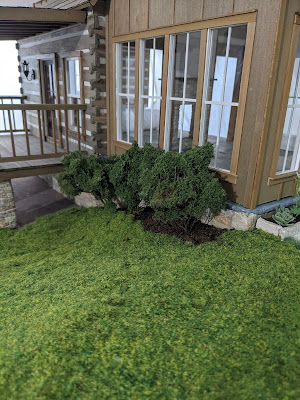Elizabeth was even there for me via email when I had a mini melt down and needed a little assistance.
18 pages of directions resulted in a perfect little kitchen for the cabin.
The sink was a coarse 3-D print out so I covered it with clear nail polish let that dry and spray painted it with white enamel paint. Then I added a little drain.
I purchased the black faucet on Etsy. It is a high quality 3-D print made by Tease Miniatures.
I opted to change the hardware on the cabinet and drawers so it was a little more rustic than modern.
This cabin could be a vacation rental or a home.
The oven is not on a hinge, but does open if you want to have something on the rack while the door is shut. It fits snuggly in the hole. I love all the buttons and dials that came with the kit.
The non-opening fridge was from Elf Miniatures as well. A beautiful piece and very affordable!
Having shelves on the wall was a must to hold dishes and I also needed some back-splash tiles. I thought I would share a realistic way to make a small area of tiles in miniature.
Measure out your area and make a file you can print on the computer (or use pre-printed tiles).
I printed mine out on card stock and cut to fit the area they would cover.
Cut a piece of clear packing tape a little longer than needed and carefully lay it over the tile print out starting on one side and slowly pressing down the tape on the paper until it covers the full length. You need to do it like this because static will move the paper as the tape gets close to it so it may end up crooked or have wrinkles.
Put some paper over it and burnish it down really well with a credit card. The paper is so you don’t scratch the tape surface.
Trim away the excess tape.
Use a small stylus ball tool and a metal ruler and run the stylus along the grout marks to make a nice indent. This gives the illusion of individual tiles.
Glue it onto the surface and rub it down as it dries.
Next up will be getting my lights all hooked up!


















































